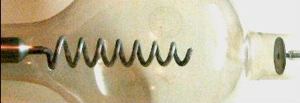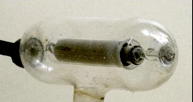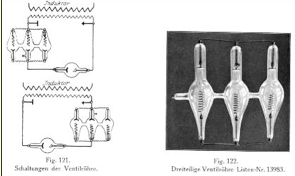Andrews Twin Rectifier Valve
Ref. H4
This tube is inspired from the Villard rectifier valve, introduced by the French scientist Paul Villard (1860-1934). Such valves have two electrodes in a relatively high vacuum, one of which is a large aluminum spiral, while the other is a small flat aluminum disc. Owing to the important asymmetry in the size of the electrodes, resistance to the passage of current is much less in one direction than in the opposite one, resulting in a significant suppression of one half wave of an alternating current.
As with other cold cathode tubes, such rectifiers harden with time, and are usually fitted with a regeneration device which could be of any type. In this valve the regeneration device is of the condenser type with one of its end connections missing.




When large currents were needed for instantaneous radiography, 2 or 3 valves were used in parallel, joined across in their mid-part, and sharing the same regeneration device. Hereafter pictures of triple valves from the Siemens and Halske catalog of 1911 with installation instructions.
The present twin valve is 16” (40cms) long and 16” (40cms) across, and the bulbs are about 5”(12,5cms) diameter. It bears on one bulb the mark “Andrews Rapid X-ray Tube, London”, and on the other bulb the faint inscription “Repaired by C. Andrews, London”*. Its manufacture date goes probably to the second decade, 20th century.
* If not the oldest in the business, the Grand Old Man among British X-ray manufacturers, Cuthbert Andrews is certainly the most colorful. He started in the X-ray business in 1910 in a basement at 35 Hatton Garden (London) with an initial cash capital of 100 Pounds allowed by Mueller of Hamburg. When imports of glass from Germany were cut off by the outbreak of WW 1, Andrews persuaded one of the big British glass houses to make soda glass bulbs for him.
(E.R.N.Grigg, “The Trail of the Invisible Light”, Charles C. Thomas, 1965 , p.507).